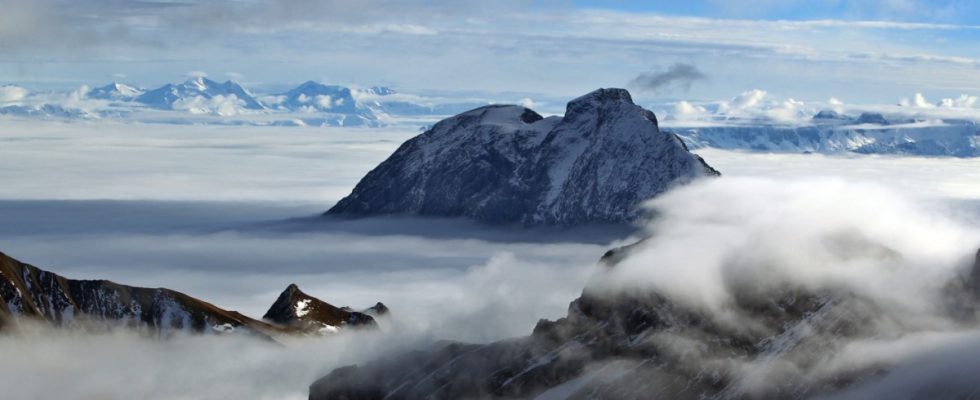From their shelter, the people probably had a wide view down to the river and to the plain forty meters below, where horses, reindeer and woolly rhinos roamed the cold Stone Age landscape. It must have been a dwelling with a magnificent view – in an inhospitable, barren environment in which the people were simply concerned with survival.
Exactly in the entrance area of this cave in Ranis in what is now Thuringia, an international research team made a discovery that could lead to a rethinking of the early settlement history of Europe. In sediments, scientists found not only blade-shaped stone devices, but also human bones of the genus Homo sapiens. The dating brought a huge surprise: the bone fragments are 45,000 years old. These are the oldest bones of anatomically modern humans ever found north of the Alps. Modern humans reached northern, cold Central Europe earlier than long assumed and lived there together with Neanderthals for several thousand years, according to the research team in three articles in the trade magazines Nature and Nature Ecology & Evolution reported.
“The site in Ranis proves how early Homo sapiens spread to the northern latitudes of Europe,” says Jean-Jacques Hublin, one of the project leaders and former director at the Max Planck Institute for Evolutionary Anthropology in Leipzig, who is now the chair of paleoanthropology at the Collège de France in Paris. Apparently the early immigrants penetrated northern Central Europe at least 45,000 years ago under extremely cold climate conditions; back then it was on average around ten degrees Celsius colder than today. They sought shelter in caves like Rani’s and hunted the animals of the cold steppe landscapes. “The finds and analyzes fundamentally change our knowledge about the transition period from Neanderthals to Homo sapiens,” says Hublin. “It is now clear that Central Europe was home to two parallel human species for at least four thousand years.”
When Homo sapiens came over the Alps, it was around ten degrees Celsius colder than today
The extensive excavations in the entrance area of the Ilsenhöhle under Ranis Castle began in 2016. The researchers wanted to better understand old finds from the 1930s and, above all, to assign the layers of finds precisely in time. During an excavation at the time, fantastically crafted leaf-shaped arrowheads as well as stone blades and bone remains were discovered in the cave, some with cut marks from stone blades. However, researchers almost a hundred years ago did not work with today’s modern methods. “It was not clear whether there were still enough sediments to support finds after the excavations in the 1930s,” says archaeologist Marcel Weiss, who was involved in all three papers now published and researches at the Friedrich-Alexander University of Erlangen-Nuremberg .
But no one had dug under a boulder that was once part of the cave roof and had fallen down over the millennia. That was a stroke of luck, as this section was right next to the old excavation areas. This made it easier to assign earlier finds. The archaeologists dug eight meters into the depths. This is how they got back in time, layer by layer. Over thousands of years, various sediments had been deposited in the cave, along with bones and other remains of people and animals.
In Ranis, the archaeologists dug down eight meters.
(Photo: Marcel Weiss)
Because of the depth and the many large stones, the researchers had to keep the shaft narrow; it was limited to around two square meters, says Weiss: “We were surprised to find four human bones in this small area.” In total, the team discovered 13 human remains, nine of them among the fossils from the old 1930 excavation that could not be identified at the time.
So-called paleoproteomics helped the anthropologists to assign the bone fragments to a specific human species. A species is determined via individual proteins in bone collagen. The researchers dated these bones and other organic remains from the find layer to 45,000 years old using the so-called radiocarbon method; an age of up to 47,500 years is even possible. To date there have been no confirmed finds from this period. There is evidence that Homo sapiens appeared in the Rhône Valley in southern France around 54,000 years ago and already had superior technology with bows and arrows, as Ludovic Slimak from the University of Toulouse Jean Jaurès wrote in the specialist magazine in 2022 Science Advances reported. But these works are controversial. Confirmed evidence only existed from the Bacho Kiro Cave in what is now Bulgaria, where Homo sapiens settled around 44,000 years ago. All other finds from Central and Northern Europe are younger.
The researchers are also excited about the fact that there were also stone tools in the layer with the human bones, the so-called gray layer of Ranis. Similar, technically complex stone implements were already known from excavations in the 1930s. It is called the culture or technological complex of the LRJ (Lincombien-Ranisien-Jerzmanowicien). “We previously thought that the arrowheads and stone blades from the cave came from late Neanderthals,” says Jean-Jacques Hublin. But apparently it was completely different. “It is very important for us archaeologists that they can now be clearly assigned to modern humans,” says Marcel Weiss. Because they allow conclusions to be drawn about other cave sites in Europe: there are finds of the LRJ culture from today’s Moravia in the Czech Republic through southeastern Poland to the British Isles in the west.
People came to Europe in small groups, not large groups
This also makes it clearer how Central Europe was populated 45,000 years ago. At that time, individual groups of around 25 people were moving around the region. Researchers have long thought that modern humans immigrated in waves and, thanks to their superior strength, drove Neanderthals out of their territories. “Now we see: It was a slow process, small groups came and took over certain regional areas,” says Hublin. There was a back and forth in the settlement of attractive habitats. During a transitional period, there was a kind of “patchwork” of populations and cultures like the LRJ, from both Homo sapiens and Neanderthals. At the LRJ complex, Hublin only counts a few hundred people at most. They were the first settlers of the Homo sapiens species.
What is also astonishing is the climatic conditions under which this immigration took place. It was long thought that Neanderthals, who had survived on the cold continent for decades, had advantages over Homo sapiens, who arrived from the warmer regions of Africa. “We now see that in the long term, modern humans survived in cold Central Europe and, of all things, Neanderthals withdrew to warmer southwestern Europe and then died out,” says Hublin. “That is amazing.”

Researcher Sarah Pederzani examines remains of animal teeth to reconstruct the climate of ancient times.
(Photo: Max Planck Institute for Evolutionary Anthropology)
The research team has now managed to accurately reconstruct the environmental conditions at the time. 45,000 years ago, the region had a cold, almost treeless tundra climate, similar to today’s northwestern Russia or Finland, researchers led by Sarah Pederzani from the Max Planck Institute for Evolutionary Anthropology in Leipzig found. “Until now, it was assumed that humans’ resistance to cold climate conditions only emerged several thousand years later,” says Pederzani. “Our result is therefore quite surprising. Perhaps cold steppes with larger herds of prey were more attractive to these groups of people than previously thought.”
In any case, the analyzes of the animal bones from the cave show that people were able to kill large mammals in the barren landscape with their hunting tools and stone arrowheads, especially reindeer, horses, woolly mammoths and woolly rhinos. Maybe that was exactly their survival advantage. And so they never stayed in one place for too long, but followed the herds. The Ranis finds are ultimately “the result of many short stays by people,” says Marcel Weiss. And whenever people were away, the excavations also show, the predators in the area returned, cave bears and especially cave hyenas. Ultimately, the cave with a view remained their territory.

